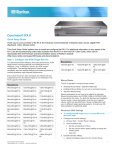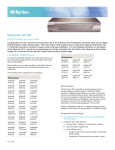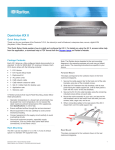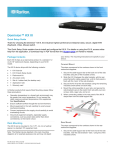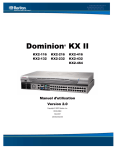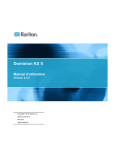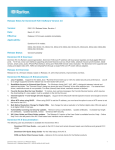Download Raritan DOMINION KX II DKX2-0E-E Setup guide
Transcript
Dominion® KX II Quick Installation and Setup Guide Congratulations on your purchase of the KX II, the industry's most full-featured, enterprise class, secure, digital KVM (Keyboard, Video, Mouse) switch. This Quick Setup Guide explains how to install and configure the KX II. For more detailed information on any aspect of the KX II, consult the accompanying online help accessed from the KX II or from the KX II User Guide, which can be downloaded from the Firmware & Documentation page on Raritan's website. Step 1: Configure the KVM Target Servers For optimal bandwidth efficiency and video performance, KVM target servers running graphical user interfaces such as Windows, Linux, X-Windows, Solaris, and KDE require configuration. The desktop background need not be completely solid but desktop backgrounds featuring photos or complex gradients might degrade performance. Ensure that the server video resolution and refresh rate are supported by KX II (and that the signal is non-interlaced). The KX II supports these resolutions: • • • Absolute Mouse Mode (D2CIM-VUSB only) Intelligent Mouse Mode (do not use an animated mouse) Standard Mouse Mode Mouse parameters do not have to be altered for Absolute Mouse Synchronization but D2CIM-VUSB is required for this mode. For both the Standard and Intelligent mouse modes, mouse parameters must be set to specific values, which are described here. Mouse configurations will vary on different target operating systems. Consult your OS documentation for additional detail. Windows® 2000 Settings Resolutions To configure KVM target servers running Microsoft Windows 2000: 640x350 @70 Hz 720x400 @85 Hz 1024x768 @90 Hz 640x350 @85 Hz 800x600 @56 Hz 1024x768 @100 Hz 640x400 @56 Hz 800x600 @60 Hz 1152x864 @60 Hz 640x400 @84 Hz 800x600 @70 Hz 1152x864 @70 Hz 640x400 @85 Hz 800x600 @72 Hz 1152x864 @75 Hz 640x480 @60 Hz 800x600 @75 Hz 1152x864 @85 Hz 640x480 @66.6 Hz 800x600 @85 Hz 1152x870 @75.1 Hz 640x480 @72 Hz 800x600 @90 Hz 1152x900 @66 Hz 640x480 @75 Hz 800x600 @100 Hz 1152x900 @76 Hz 640x480 @85 Hz 832x624 @75.1 Hz 1280x960 @60 Hz 640x480 @90 Hz 1024x768 @60 Hz 1280x960 @85 Hz 640x480 @100 Hz 1024x768 @70 Hz 1280x1024 @60 Hz 1. Configure the mouse settings: a. Choose Start > Control Panel > Mouse. b. Click the Motion tab. Set the acceleration to None. Set the mouse motion speed setting to exactly the middle speed. Click OK. 2. Disable transition effects: a. Select the Display option from the Control Panel. b. Click the Effects tab. c. Deselect the "Use the following transition effect for menus and tooltips" option. d. Click OK. e. Close the Control Panel. 640x480 @120 Hz 1024x768 @72 Hz 1280x1024 @75 Hz Windows® XP and 2003 Settings 720x400 @70 Hz 1024x768 @75 Hz 1280x1024 @85 Hz 720x400 @84 Hz 1024x768 @85 Hz 1600x1200 @60 Hz Mouse Modes To configure KVM target servers running Microsoft Windows XP/2003: 1. Configure the mouse settings: a. Choose Start > Control Panel > Mouse. b. Click the Pointer Options tab. c. In the Motion group: The KX II operates in several mouse modes: KX II Quick Setup Guide QSG-DKX2-v2.1.0-0E-E y 255-62-4022-00 1 Set the mouse motion speed setting to exactly the middle speed. Disable the Enhanced pointer precision option. Disable the Snap To option. Click OK. 2. Disable transition effects: a. Select the Display option from the Control Panel. b. Click the Appearance tab. c. Click the Effects button. d. Deselect the "Use the following transition effect for menus and tooltips" option. e. Click OK. 3. Close the Control Panel. Windows® Vista Settings To configure KVM target servers running Microsoft Windows Vista: 1. Configure the mouse settings: a. Choose Start > Settings > Control Panel > Mouse. b. Click the Pointer Options tab. c. In the Motion group: Set the mouse motion speed setting to exactly the middle speed. Disable the "Enhanced pointer precision" option. Click OK. 2. Disable animation and fade effects: a. Select the System option from the Control Panel. b. Select Performance Information then Tools > Advanced Tools > Adjust to adjust the appearance and performance of Windows. c. Click the Advanced tab. d. Click the Settings button in the Performance group. The Performance Options dialog appears. e. Under Custom options, deselect the following checkboxes: Animation options: Animate controls and elements inside windows Animate windows when minimizing and maximizing Fade options: Fade or slide menus into view Fade or slide ToolTips into view Fade out menu items after clicking 3. Click OK. 4. Close the Control Panel. Linux® Settings (Standard Mouse Mode only) Set the mouse acceleration to exactly 1 and set the threshold to exactly 1. Enter this command: xset mouse 1 1. This should be set for execution upon login. Sun Solaris™ Settings 1. Set the mouse acceleration value to exactly 1 and the threshold to exactly 1. 2. Ensure that your video card is set to a supported resolution and that its output is VGA (not composite sync). Apple® Macintosh Settings Use the D2CIM-VUSB and Absolute Mouse Synchronization. IBM® AIX Settings Go to the Style Manager, click on Mouse Settings and set Mouse Acceleration to 1.0 and Threshold to 3.0. Access and Control Target Servers Remotely The KX II Port Access page provides a list of all KX II ports, the connected target servers, their status, and availability. Access a Target Server To access a target server: 1. Click the Port Name of the target you want to access. The Port Action Menu is displayed. 2. Choose Connect from the Port Action menu. The video display switches to the target server interface. Switch between Target Servers To switch between KVM target servers: 1. While already using a target server, access the KX II Port Access page. 2. Click the port name of the target you want to access. The Port Action menu appears. 3. Choose Switch From in the Port Action menu. The Virtual KVM Client window switches to the new target server you selected. Disconnect a Target Server To disconnect a target server: 1. Click the port name of the target you want to disconnect. The Port Action menu appears. 2. Choose Disconnect. QS Rule Step 2: Configure Network Firewall Settings To enable remote access to the KX II, your network and firewall must allow communication on TCP Port 5000. You can also configure the KX II to use a different TCP port, then allow communication on that port. To access he KX II via Web browser, your firewall must also allow access to TCP Port 443 (Standard HTTPS). Access to TCP Port 80 (Standard HTTP) enables automatic redirection of "HTTP" requests to "HTTPS". QS Rule KX II Quick Setup Guide QSG-DKX2-v2.1.0-0E-E y 255-62-4022-00 2 Step 3: Connect the Equipment D. Local Access Port (Local PC) For convenient access to target servers while at the rack, use the Dominion KX II Local Access port. While the local port is required for installation and setup, it is optional for subsequent use. The local port also provides a graphical user interface (the KX II Local Console) for administration and target server access. Attach a multi-sync VGA monitor, mouse, and keyboard to the respective Local User ports, using either a PS/2 or USB keyboard and mouse. E. Target Server Ports A. AC Power The KX II uses standard UTP cabling (Cat5/5e/6) to connect to each target server. To connect the power supply: 1. Attach the included AC power cord to the KX II and plug into an AC power outlet. 2. For dual power failover protection, attach the second included AC power cord and plug it into a different power source than the first power cord. Note: If you only attach one power cord, the power LED on the KX II front panel will be red because the system is set to automatically detect both sources. See Power Supply Setup in the KX II help for information about turning off automatic detection for the power source that is not in use. B. Modem Port (Optional) Please see the KX II User Guide for information on connecting modems. C. Network Port The KX II provides two Ethernet ports for failover purposes (not for load-balancing). By default, only LAN1 is active and the automatic failover is disabled. When enabled, if the KX II internal network interface or the network switch to which it is connected becomes unavailable, LAN2 will be enabled using the same IP address. To connect the network: 1. Connect a standard Ethernet cable (included) from the network port labeled LAN1 to an Ethernet switch, hub, or router. 2. To make use of the optional KX II Ethernet failover capabilities: Connect a standard Ethernet cable from the network port labeled LAN2 to an Ethernet switch, hub, or router. Enable Automatic Failover on the Network Configuration page. KX II Quick Setup Guide QSG-DKX2-v2.1.0-0E-E y 255-62-4022-00 To connect a target server to the KX II: 1. Use the appropriate Computer Interface Module (CIM). 2. Attach the HD15 video connector of your CIM to the video port of your target server. Ensure that your target server's video has already been configured to a supported resolution and refresh rate. For Sun servers, also ensure that your target server's video card has been set to output standard VGA (H-and-V sync) and not composite sync. 3. Attach the keyboard/mouse connector of your CIM to the corresponding ports on your target server. Using a standard straight-through UTP (Cat5/5e/6) cable, connect the CIM to an available server port on the back of your KX II device. A new switch position takes effect only after the CIM is power-cycled. To power-cycle the CIM, remove the USB connector from the target server and plug it back in a few seconds later. QS Rule Step 4: Configure the KX II Change the Default Password The KX II ships with a default password. The first time you start the KX II you are required to change that password. 1. Power ON the KX II using the power switch at the back of the device. Wait for the KX II device to boot. (A beep signals completion of the boot.) 2. Once the device has booted, the KX II Local Console is visible on the monitor attached to the KX II local port. Type the default username (admin) and password (raritan) and click Login. The Change Password screen is displayed. 3. Type your old password (raritan) in the Old Password field. 4. Type a new password in the New Password field; retype the new password in the Confirm New Password field. Passwords can be up to 64 characters long and can consist of English alphanumeric and printable special characters. 5. Click Apply. 3 6. You will receive confirmation that the password was successfully changed. Click OK. The Port Access page opens. Assign an IP Address These procedures describe how to assign an IP address on the Network Settings page. 1. From the KX II Local Console, choose Device Settings > Network. The Network Settings page opens. 2. Specify a meaningful Device Name for your KX II device using up to 16 alphanumeric characters, valid special characters, and no spaces. 3. In the IPv4 section, enter or select the appropriate IPv4-specific network settings: a. Enter the IP Address if needed. The default IP address is 192.168.0.192. b. Enter the Subnet Mask. The default subnet mask is 255.255.255.0. c. Enter the Default Gateway if None is selected from the IP Auto Configuration drop-down. d. Enter the Preferred DHCP Host Name if DHCP is selected from the IP Auto Configuration drop-down. Note: The host name cannot exceed 232 characters in length. e. Select the IP Auto Configuration. The following options are available: None (Static IP) - This option requires that you manually specify the network parameters. This is the recommended option because the KX II is an infrastructure device and its IP address should not change. DHCP - Dynamic Host Configuration Protocol is used by networked computers (clients) to obtain unique IP addresses and other parameters from a DHCP server. With this option, network parameters are assigned by the DHCP server. If DHCP is used, enter the Preferred host name (DHCP only). Up to 63 characters. 4. If IPv6 is to be used, enter or select the appropriate IPv6-specific network settings in the IPv6 section. See the KX II User Guide for information on configuring IPv6 settings. 5. Select Obtain DNS Server Address Automatically if DHCP is selected and Obtain DNS Server Address is enabled. When Obtain DNS Server Address Automatically, the DNS information provided by the DHCP server will be used. 6. If Use the Following DNS Server Addresses is selected, regardless of whether DHCP is selected or not, the addresses entered in this section will be used to connect to the DNS server. Enter the following information if the Following DNS Server Addresses option is selected. These addresses are the primary and secondary DNS addresses that will KX II Quick Setup Guide QSG-DKX2-v2.1.0-0E-E y 255-62-4022-00 be used if the primary DNS server connection is lost due to an outage. a. Primary DNS Server IP Address b. Secondary DNS Server IP Address 7. When finished, click OK. Your KX II device is now network accessible. Name Target Servers To name the target servers: 1. Connect all of the target servers if you have not already done so. 2. Using the KX II Local Console, choose Device Settings > Port Configuration. The Port Configuration page opens. Specify Power Supply Auto Detection The KX II provides dual power supplies, and can automatically detect and provide notification regarding the status of these power supplies. Use the Power Supply Setup page to specify whether you are using one or both of the power supplies. Proper configuration ensures that the KX II sends the appropriate notifications should a power supply fail. For example, if power supply number one fails, the power LED at the front of the device will turn red. To enable automatic detection for the power supplies in use: 1. Choose Device Settings > Power Supply Setup. The Power Supply Setup page opens. 2. If you are plugging power input into power supply number one (left-most power supply at the back of the device), then select the Powerln1 Auto Detect option. 3. If you are plugging power input into power supply number two (right-most power supply at the back of the device), then select the Powerln2 Auto Detect option. 4. Click OK. Note: If either of these checkboxes is selected and power input is not actually connected, the power LED at the front of the device turns red. Create User Groups and Users To add a new user group: 1. Open the Group page by selecting User Management > Add New User Group or clicking the Add button from the User Group List page. The Group page is organized into the following categories: Group, Permissions, Port Permissions, and IP ACL. 2. Type a descriptive name for the new user group into the Group Name field. 3. Set the permissions for the group. Select the checkboxes before the permissions you want to assign to all of the users belonging to this group. 4 4. Set the port permissions. Specify the server ports that can be accessed by users belonging to this group (and the type of access). 5. Set the IP ACL. This feature limits access to the KX II device by specifying IP addresses. It applies only to users belonging to a specific group, unlike the IP Access Control list feature that applies to all access attempts to the device (and takes priority). Optional 6. Click OK. (732) 764-8887, or email [email protected], Monday - Friday 8:00 AM to 8:00 PM EST. To add a new user: 1. Open the User page by choosing User Management > Add New User or clicking the Add button on the User List page. 2. Type a unique name in the Username field (up to 16 characters). 3. Type the person's full name in the Full Name field (up to 64 characters). 4. Type a password in the Password field and retype the password in the Confirm Password field (up to 64 characters). 5. Choose the group from the User Group drop-down list. The list contains all groups you have created in addition to the system-supplied default groups (<Unknown> (default setting), Admin, Individual Group). If you do not want to associate this user with an existing User Group, select Individual Group from the drop-down list. 6. To activate the new user, select the Active checkbox. The default is activated (enabled). 7. Click OK. QS Rule Step 5: Launch the KX II Remote Console To launch the KX II Remote Console: 1. Log on to any workstation with network connectivity to your KX II and Java Runtime Environment installed (JRE is available at http://java.sun.com/ http://java.sun.com). 2. Launch a supported web browser such as Internet Explorer (IE) or Firefox. 3. Type the following URL: http://IP-ADDRESS, where IP-ADDRESS is the IP address that you assigned to your KX II. You can also use https, the DNS name of the KX II assigned by the administrator (provided that a DNS server has been configured), or just simply type the IP address in the browser (KX II always redirects the IP address from HTTP to HTTPS.) The Login page opens. 4. Type your Username and Password. Click Login. QS Rule Additional Information For more information about the KX II and the entire Raritan product line, refer to the Raritan User Guide & Quick Setup Guides CD ROM or Raritan's website http://www.raritan.com/support. For technical issues, contact Raritan Technical Support by telephone (732) 764-8886, fax KX II Quick Setup Guide QSG-DKX2-v2.1.0-0E-E y 255-62-4022-00 5





